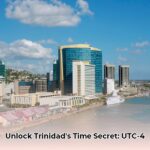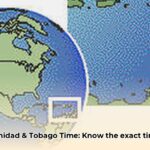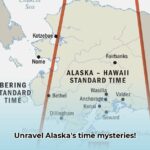Trinidad and Tobago observes Atlantic Standard Time (AST), which is consistently UTC-4. This comprehensive guide explores the nuances of this fixed time zone, covering its impact on businesses, tourism, daily life, and international interactions.
Navigating Time in Trinidad & Tobago: A Practical Perspective
Trinidad and Tobago’s year-round adherence to AST, without Daylight Saving Time (DST), simplifies scheduling and eliminates the need for biannual clock adjustments. This consistency benefits local businesses and residents, streamlining daily operations and personal schedules. However, this fixed time zone presents unique considerations when interacting with countries that observe DST.
Understanding AST in a Global Context
Maintaining AST year-round means the time difference between Trinidad and Tobago and other locations shifts depending on their DST observance. For example, the difference between Port of Spain and New York City varies by an hour depending on the time of year. This dynamic requires careful attention from international businesses and travelers. Clear communication of meeting times and deadlines is crucial for effective international collaboration. This also affects travelers coordinating flight schedules and connecting itineraries. Knowing the exact time difference is essential for avoiding missed connections and ensuring smooth travel experiences.
Practical Tips for Managing Time Differences
These tips will help you navigate Trinidad and Tobago’s time zone:
- Utilize online time converters: Websites and apps provide instant AST conversions to your local time, facilitating accurate scheduling. Some tools even offer meeting planners that consider multiple time zones simultaneously.
- Communicate transparently: When scheduling international calls or meetings, explicitly state that times are in AST. Including the corresponding UTC offset (UTC-4) further clarifies and minimizes potential confusion.
- Synchronize devices: Ensure all your devices accurately reflect AST to avoid scheduling conflicts. Activating automatic time zone updates on your devices can prevent discrepancies.
Trinidad & Tobago Time and International Business
Trinidad and Tobago’s fixed AST presents both challenges and opportunities for international business. Strategic planning and clear communication are essential for successful collaboration.
The Impact of AST on Global Business Operations
While a consistent time difference simplifies some scheduling aspects, the fixed offset can create challenges for real-time communication and project management. Consider the impact on businesses collaborating with European partners. The consistent four-hour difference can limit overlap in working hours, potentially hindering immediate responses and requiring flexible work arrangements. Overcoming these obstacles requires proactive planning and effective communication strategies.
Strategies for Effective International Collaboration
These strategies enhance cross-time zone collaboration:
- Establish clear communication protocols: Implement detailed communication plans, outlining preferred communication channels, expected response times, and escalation procedures for urgent matters. This ensures everyone is on the same page and communication flows smoothly.
- Respect time zones: When scheduling meetings, consider all participants’ time zones and aim for times that are convenient for everyone. Rotating meeting times can also ensure fairness over long-term projects. Using scheduling tools that automatically convert times can streamline this process.
- Leverage technology: Utilize video conferencing, project management software, and instant messaging platforms to facilitate seamless collaboration. These tools bridge geographical distances and facilitate real-time communication, despite time differences. Cloud-based document sharing also promotes efficient teamwork.
Trinidad & Tobago Time and Tourism
Trinidad and Tobago’s consistent time zone offers unique advantages for the tourism sector, benefiting both visitors and tourism-related businesses.
The Advantages of Consistent Time for the Tourism Industry
The absence of DST provides predictability for tourists, simplifying itinerary planning. This consistency streamlines flight and tour scheduling, ensuring smooth travel experiences. For tourism businesses, it simplifies staff scheduling and resource allocation, enhancing operational efficiency. This predictable time zone also simplifies marketing efforts, as businesses can confidently advertise consistent operating hours and tour schedules throughout the year.
The Future of Time and Tourism in Trinidad & Tobago
While the current system functions effectively, ongoing evaluation remains vital. As global travel patterns evolve, analyzing the long-term impacts of a fixed time zone helps the tourism sector maintain competitiveness and adapt to future trends. Factors to consider include the potential impact on flight schedules and connectivity, the changing preferences of international travelers, and the alignment of Trinidad and Tobago’s time zone with key tourism markets. This proactive approach ensures the country remains an attractive and accessible destination.
- Master Crypto Trading: Sentiment Analysis Guide - June 24, 2025
- Master Crypto Fear & Greed Index Live: Smart Trading Guide - June 24, 2025
- Master Crypto Market Price Alerts: 2024’s Top Tools - June 24, 2025
















